BIOL 107 FINAL EXAM
1/140
Earn XP
Description and Tags
EXAM #5
Name | Mastery | Learn | Test | Matching | Spaced |
|---|
No study sessions yet.
141 Terms
Life continues through the formation of ________ and _________
new cells and new organisms
Reproduction ensures ____________
survival of species across genereations
Reproduction allows transfer of genetic __________ from ______ → _________
information from parent → offspring
2 Major Strategies of Reproduction
Asexual (clones)
Sexual (genetic variation)
What reproduction do humans use?
BOTH!
our body cells(somatic cells) undergo asexual reproduction – mitosis
The only cells that go sexual reproduction – gametes
DNA contains genes that ________
provide instructions for building proteins
DNA is packaged into __________
chromosomes
_____________ is characteristic for a species
Chromosome number
Humans have ____ chromosomes ( ___ pairs)
46, 23
Diploid (__n)
____ sets of chromosomes
____ set from each ________
Most human cells → ___n = ___
( 2n )
Two sets of chromosomes
One set from each parent
Most human cells → 2n = 46
Haploid (__n)
_____ set of chromosomes
Gametes ( ____ & ____ ) → ___n = ___
( 1n )
One set of chromosomes
Gametes (egg & sperm) → 1n = 23
2n = 4
meanings of 2, “n,” 4
4 = # of total chromosomes
2 = # of sets of chromosomes
n = # of chromosomes per set
Homologous Chromosomes
same _____
matching pair of chromosomes - one from each parent
same size, shape, genes/location
In Homologous chromosomes, though they have the same size, shape, genes, locations, they may carry ______ _________/_________
different versions/alleles
karyotype
Image showing chromosomes arranged by size and shape
Karyotype is used to detect
Chromosome number abnormalities result from non-disjunction
(e.g. Down Syndrome)
Structural changes
22 pairs of chromosomes are __________ ____________
2 pairs are ________ _____________
autosomal chromosomes, sex chromosomes
2 Major Phases of cell division
Interphase (G1, S, G2)
M phase (Mitosis + Cytokinesis)
Cells spend most of their time in _________
interphase
Cell division is regulated by ___________
internal checkpoints
Checkpoints make sure that the _______________ for the cell to _______________
right conditions exist for the cell to go through cell division
Interphase
Preparing for division
G1 phase:
Cell grows
S phase:
DNA replication → chromosomes duplicated
G2 phase:
Final growth
Checks for DNA errors
Chromosomes are duplicated but not yet condensed
G1 Phase in Interphase
cell grows
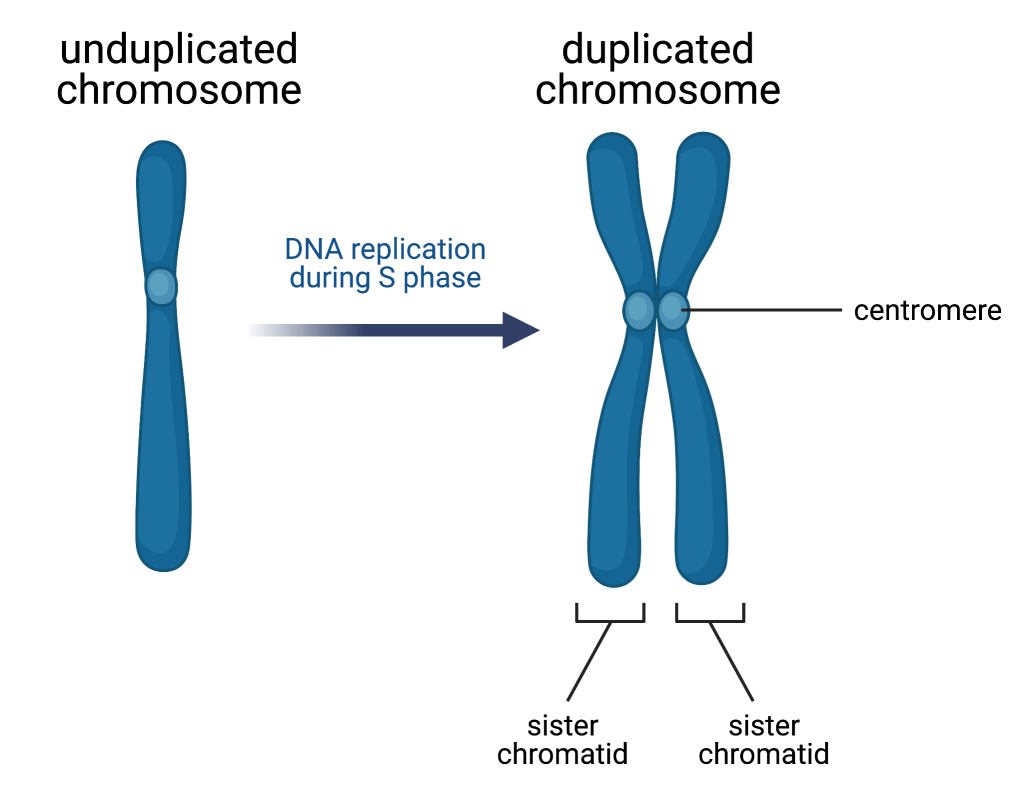
S phase
DNA replication → chromosomes duplicated
G2 phase
Final growth
Checks for DNA errors
Chromosomes are duplicated but not yet condensed
Mitosis and Cytokinesis
Produces _________
Mitosis = division of the nuclear contents
Cytokinesis = division of the cytoplasm
Produces two identical daughter cells
Why cells perform mitosis
Growth and development
Tissue repair/healing
Asexual reproduction (in some organisms)
Purpose of Mitosis
Maintains chromosome number
(2n → 2n)
Phases of Mitosis
Interphase, Prophase, Metaphase, Anaphase, Telophase, Cytokinesis
Interphase - Mitosis
DNA was replicated
Prophase - Mitosis
Chromosomes condense; spindle aparatus develops/forms
Nuclear envelope breaks down
Centrosome (pair of centrioles), move towards opposite ends of the cell
Mitosis - During prophase, centrosomes(pair of centrioles) move toward _____________
opposite ends of the cell
Prometaphase - Mitosis
(spindle apparatus attaches to condensed chromosomes)
Metaphase - Mitosis
chromosomes line up at the cell’s equator
Anaphase - Mitosis
sister chromatids separate and move to opposite poles
Mitosis - During anaphase, sister chromosomes _______ and move to _________?
separate, opposite poles
Telophase - Mitosis
Chromosomes decondense, new nuclei form
cleavage furrow
reverse of prophase
During telophase, chromosomes ______ and new _______ form
decondense, nuclei
Cytokinesis
cytoplasm divides; producing two daughter cells
What does cytokinesis produce?
two daughter cells
Key features of mitosis
Produces 2 genetically identical cells
Diploid → diploid
1 round of cell division
No homologous chromosome pairing
No crossing over
Mitosis has no __________ and no _________
homologous chromosome pairing, crossing over
Why does sexual reproduction requires meiosis?
Reduces chromosome number (diploid → haploid)
Produces gametes (egg & sperm)
Increases genetic variation
Meiosis increases genetic variation through:
Crossing over
Independent assortment
Random fertilization
Mitosis makes _____ cells
somatic cells(body cells)
*makes MY TOES*
Meiosis makes ______
gametes (reproductive/sex cells)
*makes ME*
Crossing over - 3 steps
Homologous chromosomes pair up in synapse
DNA exchanged through crossing over
Produces recombinant chromosomes

Meiosis Phases
Interphase, Meiosis I, Meiosis II
Meiosis I
separation of ______
_______ reduces ( __ → __ )
Separation of homologous chromosomes
Ploidy reduces (diploid → haploid)
Prophase I, Metaphase I, Anaphase I, Telophase I & Cytokinesis
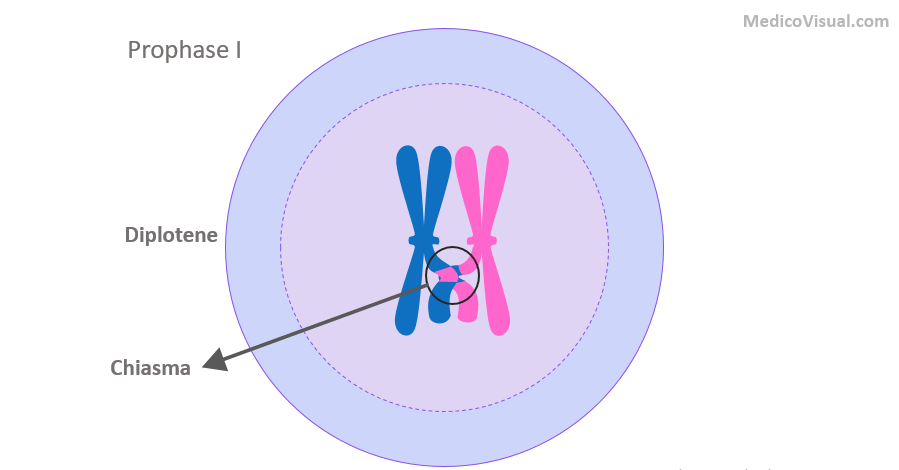
Prophase I - Meiosis I
homologous chromosomes pair (snapsis); crossing over occurs
2n
Metaphase I - Meiosis I
tetrads align at metaphase plate
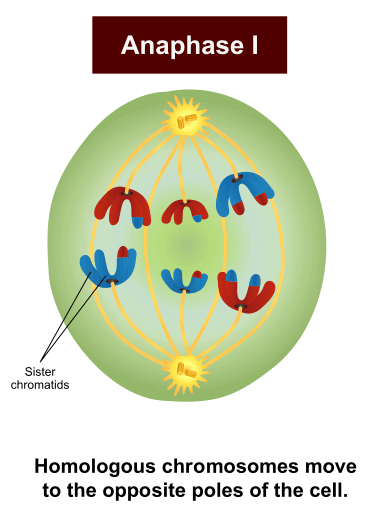
Anaphase I - Meiosis I
homologous pairs separate
Telophase I & Cytokinesis - Meiosis I
2 cells, each haploid, form; chromosomes still duplicated
Sister chromatids *no longer identical due to crossing over
Meiosis I produces
two haploid cells that are genetically unique from the original parent cell
Meiosis II is a separation of ______________
sister chromatids
Meiosis II
Similar to meiosis
Sister chromatids separated → 4 haploid cells
Each gamete is genetically unique
essentially mitosis for a haploid cell
Meiosis II produces
four genetically unique haploid daughter cells from the two haploid cells that entered the stage
purpose of mitosis
growth/repair
purpose of meiosis
gamete production
Reproductive System is responsible for:
Production of gametes
Protection/nourishment of developing fetus (in females)
Releasing hormones
Sexual maturity occurs between
8-13 in females
9-14 in males
Production of human somatic cells
produces _____ cells and _________
______ cell division
produces 2 ____________
______ chromosomes in human somatic cells
Mitosis
Produces somatic (body) cells AND diploid germ cells
One cell division
Produces 2 genetically identical, diploid (2n) cells
46 chromosomes in human somatic cells
Production of human somatic cells produces
2 genetically identical, diploid (2n) cells
Production of human sex cells
produce ________ cells
involved in _________
_____ cell divisions (________)
produces 4 __________
_____ chromosomes in human gametes
Meiosis
Produces sex cells (gametes)
Involved in sexual reproduction
Two cell divisions (Meiosis I & II)
Produces 4 genetically unique, haploid (1n) cells
23 chromosomes in human gametes
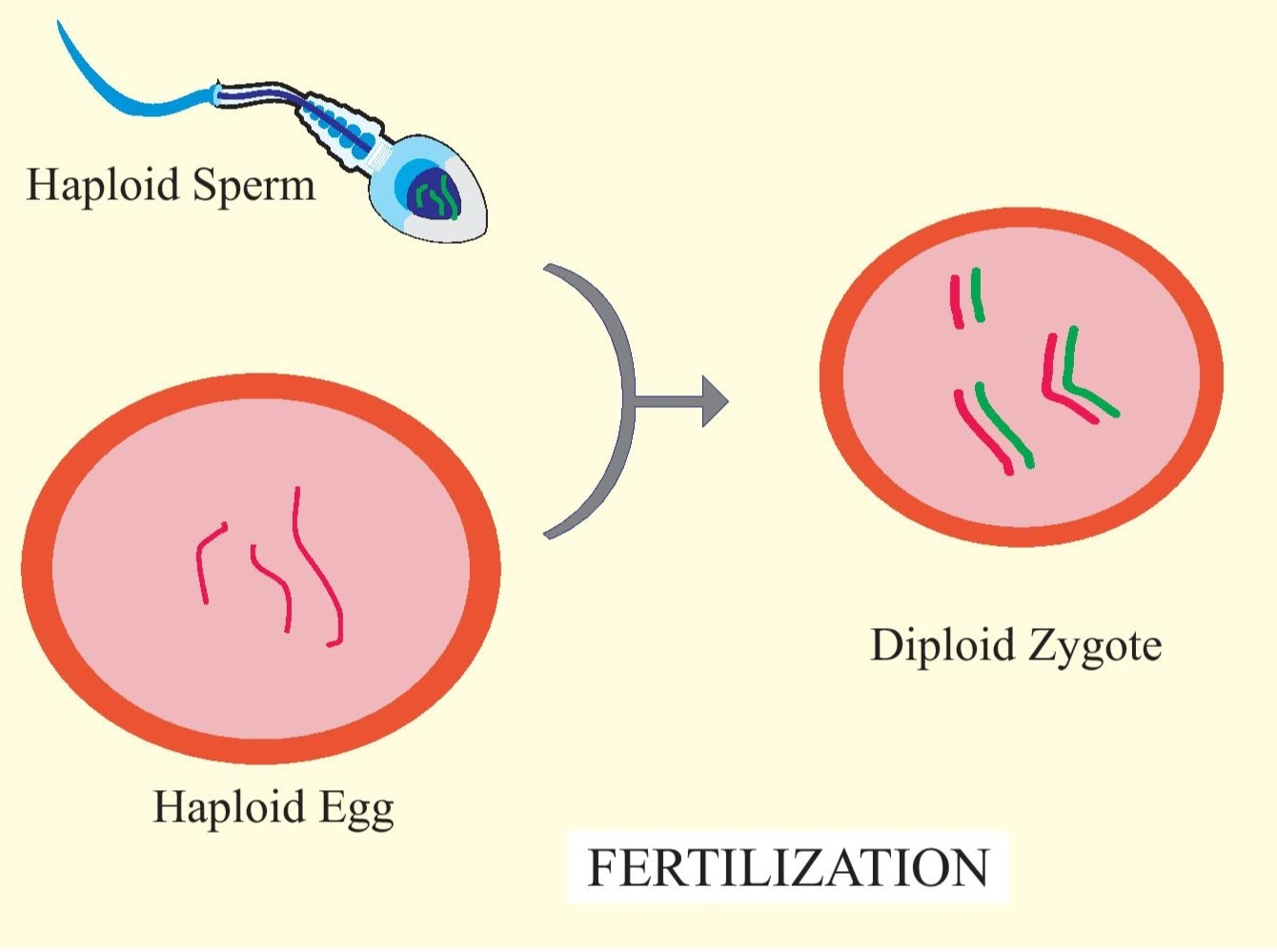
Fertilization
Restores the diploid state
Produces a zygote
Formed when a sperm cell (1n) fertilizes an ovum (1n)
Contains a complete set of chromosomes (2n) – half from each parent
Fertilization restores the _________
diploid state
Fertilization produces ___________
zygote
Fertilization is formed when ______________
Formed when a sperm cell (1n) fertilizes an ovum (1n)
Fertilization contains __________
a complete set of chromosomes (2n) – half from each parent
Zygote
Represents the first cell of new organism
Undergoes rapid cell division (cleavage) to begin embryonic development
Cleavage
rapid cell division – the cells are dividing without really growing in between
Female reproductive organs
Ovaries, Oviduct (fallopian tube), Uterus, Cervix
Ovaries
Produce hormones and oocytes, immature eggs
Oviduct (fallopian tube)
Transport oocyte to uterus
Site of fertilization
Uterus
Muscular organ
Supports embryo development
Walls include:
Myometrium = muscular layer
Endometrium = inner lining; thickens and sheds during menstrual cycle
Myometrium
muscular layer in the walls of uterus
Endometrium
inner lining of the uterus; thickens and sheds during menstrual cycle
Cervix
Gateway between uterus and vagina
Oogenesis
development of the ovum
Oogenesis: Before birth
Oogonia → primary oocytes
Primary oocytes begin meiosis I and arrest in prophase I
~1–2 million present at birth
Oogenesis: At puberty
Monthly hormonal signals resume meiosis I
Primary oocyte → secondary oocyte + first polar body
Oogenesis: Ovulation
Secondary oocyte is released
Arrested in metaphase II until fertilization
Oogenesis: If fertilization occurs
Meiosis II completed
Secondary oocyte → ovum + second polar body
Pronuclei fuse → zygote
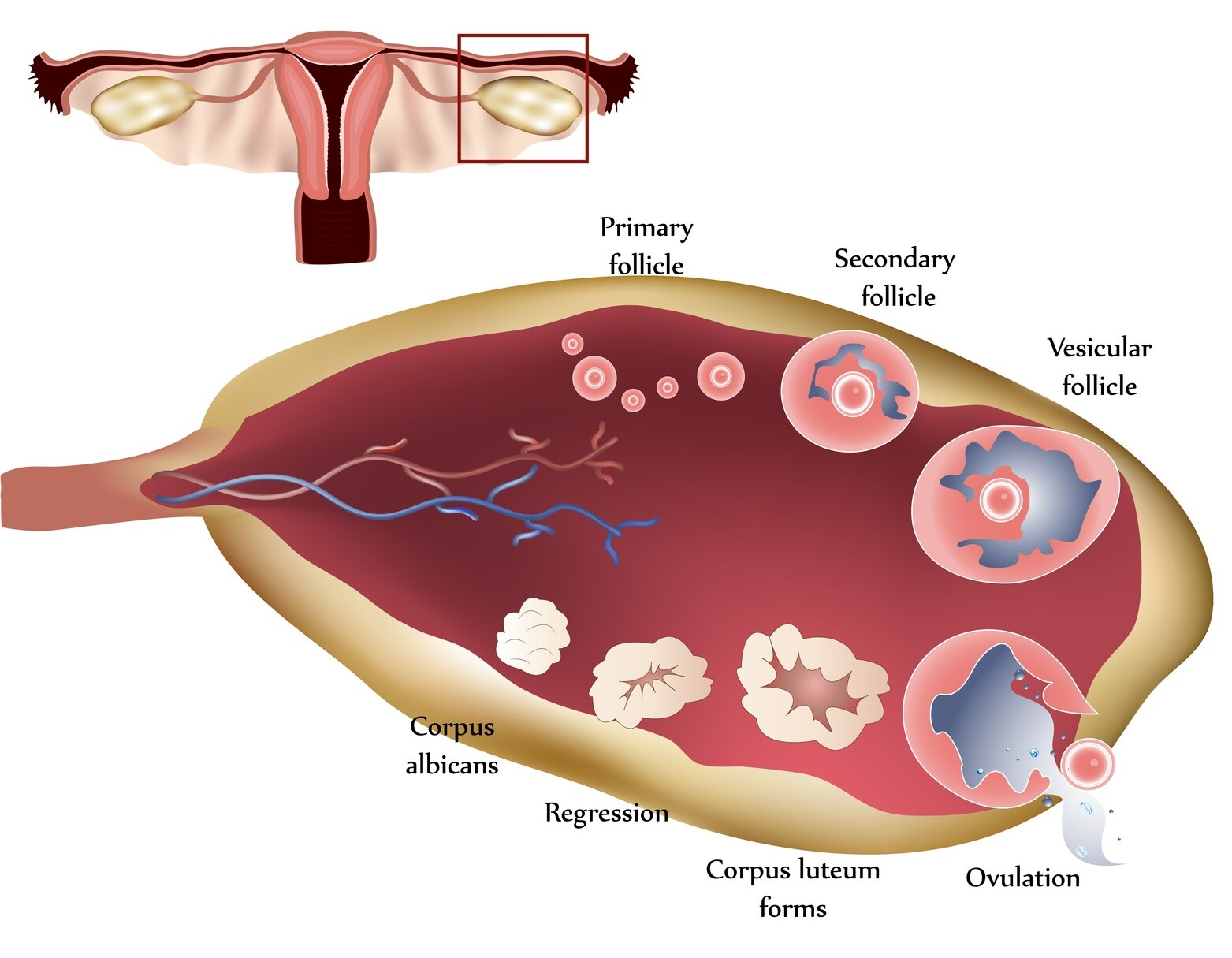
Follicle
Small, fluid-filled structure that houses and supports a developing oocyte until ovulation
the Ovarian follicle is one of the main places of __________________
estrogen production
Functions of follicle
Protects developing oocyte
Responds to FSH and produces estrogen
Matures the oocyte
Ruptures and turns into corpus luteum
Menarche
First menstruation
Between age 10-16
At birth, a female is born with ______ “____” cells they will ever produce
→ which is about ___________
ALL, “egg”
→ 1-2 million primary oocytes
At puberty, about ________________ oocytes remain
300,000-400,000
Menopause
End of menstrual cycle
Usually occurs in early 50’s when ovaries produce less estrogen and progesterone
Fertility ends when menstrual cycle permanently stops
from menarche to menopause, About ___________ oocytes ovulates
400,000
Ovarian cycle is the development of _______
oocytes
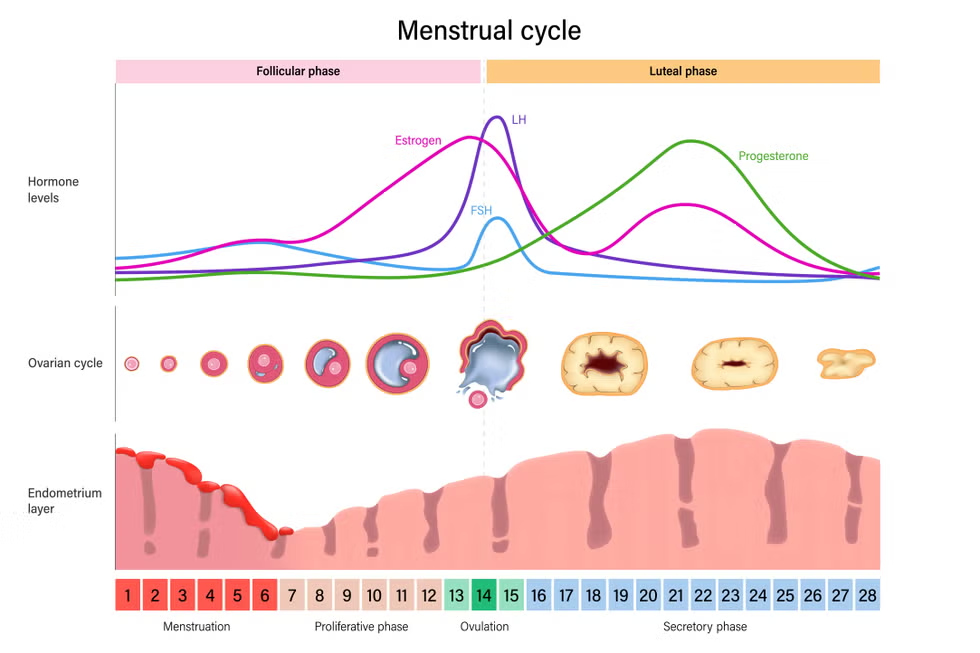
Ovarian cycle
describes monthly changes that occur in ovaries to produce and release an oocyte
Ovarian cycle phases
Follicular phase (~ days 1-14)
Ovulation (around day 14)
Luteal phase (~ days 15-28)
follicle → produces ___________
corpus luteum → produces __________
estrogen,
progesterone
If fertilization occurs, then corpus luteum __________ & progesterone __________
remains, stays up
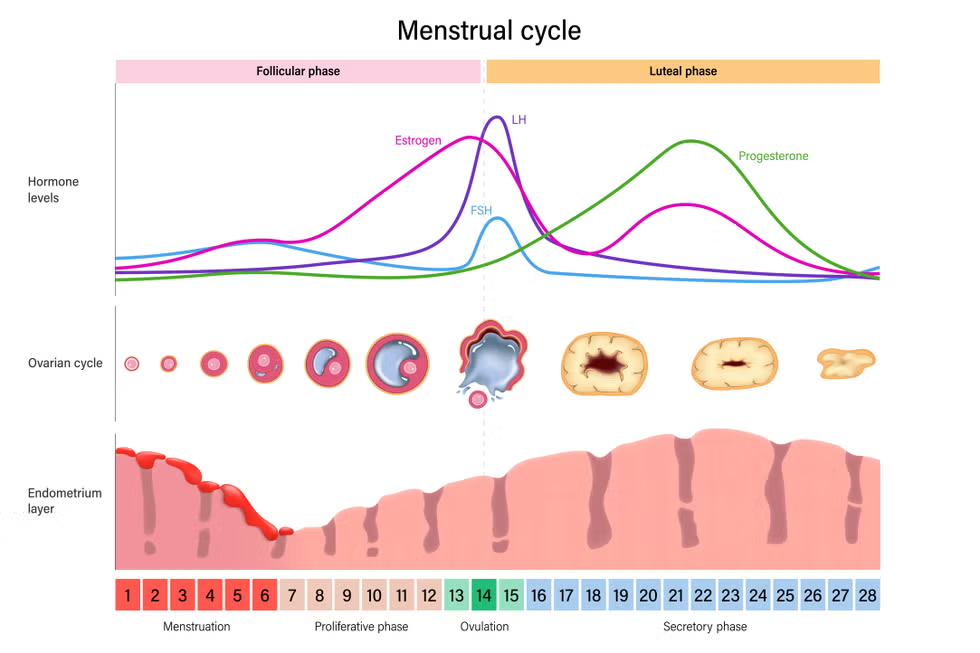
Menstrual phase ( Day____ )
(Day 1)
Shedding of endometrium
Low estrogen and progesterone
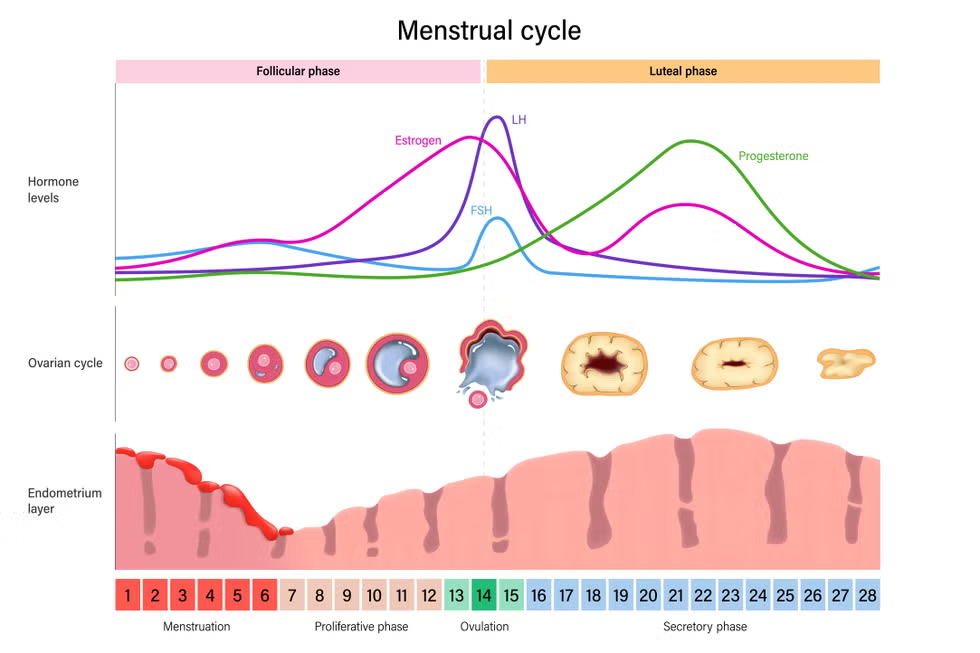
Proliferative phase ( Days ______ )
(~Days 6-14)
Estrogen from growing follicles rebuilds and thickens endometrium
Ends with ovulation
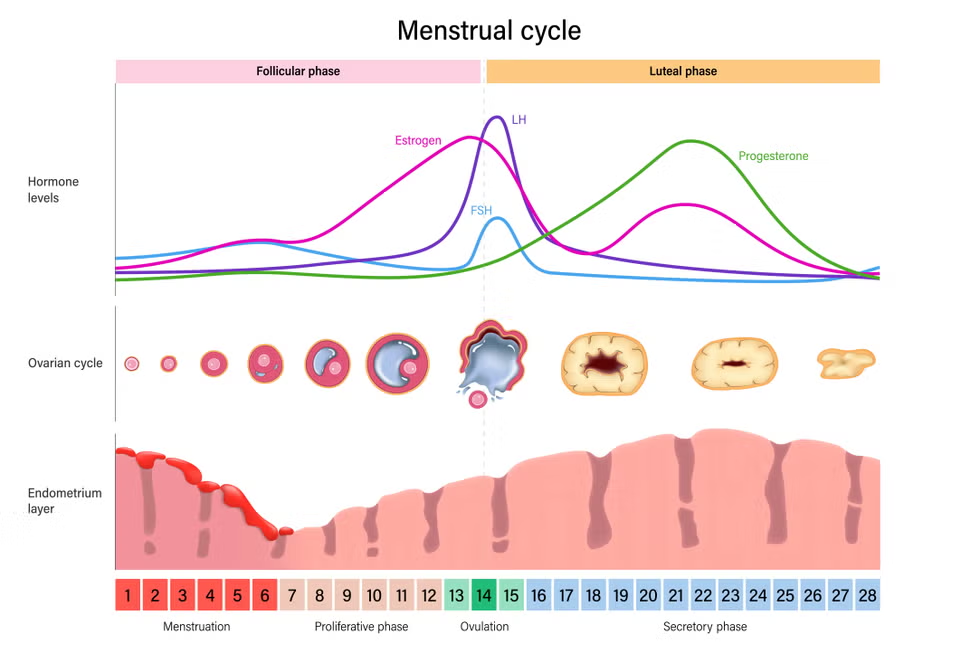
Progestational/Secretory phase ( Days ______ )
(~Days 15-28)
Progesterone from corpus luteum thickens & maintains endometrium
If no fertilization → hormone levels fall menstruation begins
If no fertilization during the progestational phase, hormone levels _________ and ___________
fall, menstruation begins